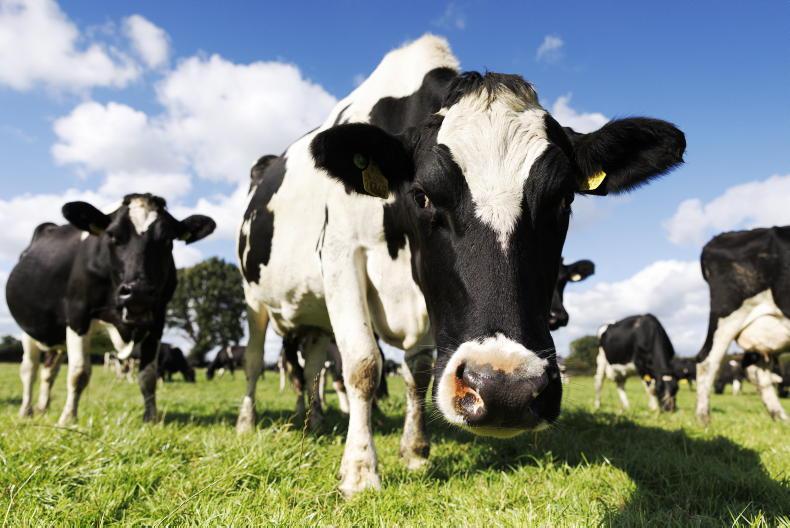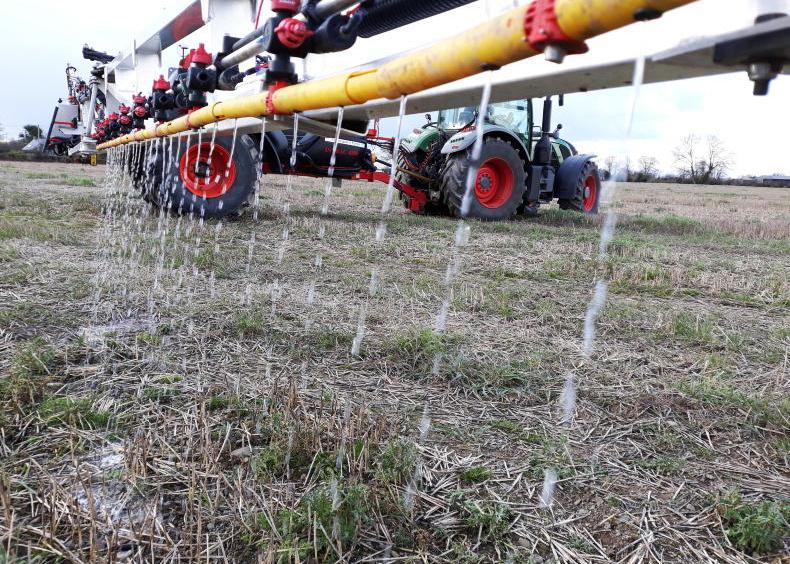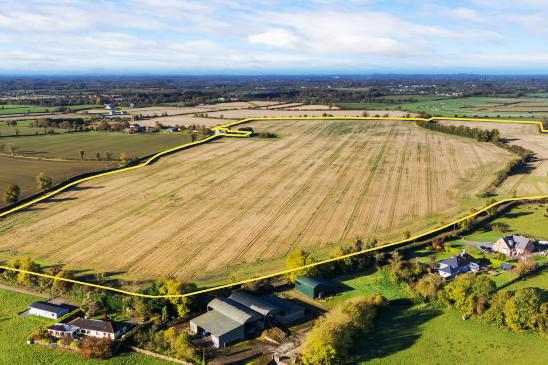As a tool for improving on-farm sustainability, hedgerows are hard to beat. Research conducted by Teagasc has estimated that there are about 58 tonnes of carbon per hectare in the above ground biomass of a hedge.
Moreover, hedgerows rank amongst the most abundant wildlife habitats present on Irish farms, forming an extensive network extending to around 700,000km.
There is a huge opportunity to capitalise on the climate and biodiversity potential of this already existing network.
Irish hedgerows can be
‘linear woodlands’
The significance of this opportunity is underscored by Ireland’s relatively low forest cover, which, at 11%, stands in stark contrast to the EU average of 39%.
Within this 11%, less than 2% of Ireland’s forest cover consists of native woodlands; the majority is comprised of forestry plantations, which offer little habitat for biodiversity.
While enhancing and creating native woodlands is crucial in terms of addressing Ireland’s climate and biodiversity challenges, our existing hedgerow networks, when allowed to grow tall and wide, can also play their part as “linear woodlands”.
When managed in this way, they can offer many of the climate and biodiversity advantages commonly associated with native woodlands.
They also have the potential to yield a variety of other benefits to farmers, such as improved animal welfare, flood mitigation and enhanced soil health.
A significant opportunity
In addition to this, research conducted by Teagasc has estimated that only approximately 1% of our hedgerow habitats are classified as of high quality.
This figure emphasises the significant opportunity that exists on many Irish farms to enhance on-farm sustainability by improving the quality of existing hedgerows.
Letting hedgerows be is an easy win on Footprint Farms
Footprint farmers are increasingly recognising the advantages of preserving old hedgerows on their properties.
Andrew Mulhare, who farms a 54-hectare mixed tillage and suckler beef farm in Co Laois, has been previously featured in these pages. Over the past two years, Andrew has been gaining a better understanding of inputs and outputs on his farm by measuring grass, and by testing soil, slurry and silage.
He has also carried out a number of actions on farm to improve soil fertility while reducing the use of chemical nitrogen, including chopping straw on tillage land and incorporating clover into grazing swards.
On his tillage land, Andrew emphasises that he is trying to reduce the use of chemical sprays through careful timing and by ploughing in, rather than spraying off, catch crops, with good success.
Looking ahead, Andrew is contemplating joining ACRES and is curious about assessing the feasibility of transitioning his beef enterprise to an organic system.
One feature, however, stands out on Andrew’s farm: marking his laneways and field boundaries are mature, tall and wide native hedgerows.

Letting hedgerows be in autumn allows species like hawthorn, blackthorn and bramble to fruit, providing crucial winter food for birds and other wildlife.
These hedgerows are a credit both to Andrew’s careful management and to the management of the generations that came before him.
They are rich in diversity, including native tree species such as holly, whitethorn, blackthorn, silver birch, oak and ash, amongst many others, and are also rich in ivy, honeysuckle and bramble – all key species for our native birds and insects.
For Andrew, letting hedgerows be is an easy win. He takes a considered approach to hedgerow management, cutting only where necessary, and working with his hedging contractor to create tall and wide ‘A’ shaped hedgerows.
Where mature hedgerows bordering tillage land are causing straw to dry more slowly, Andrew is proposing to create arable grass margins under ACRES, eliminating the issue while also boosting his farm sustainability credentials.
Hedgerows take time to mature
Better protection and supports for good quality hedgerows are a must. However, hedgerows take time to grow, or to recover from intensive cutting regimes.
Planning for the future by carefully managing your hedgerows now can provide you with a wide array of agricultural, ecological and climate benefits.
Considering the importance of hedgerows in terms of carbon and biodiversity, it might also just be the ticket in terms of qualifying for future payments.
Agricultural benefits:
Reduce runoff and soil erosion.Provide shade and shelter, promoting animal welfare and helping to reduce stress-related illnesses.Create natural barriers between fields, limiting disease spread and spray drift.Intercept plant nutrients, decreasing nitrogen and phosphorus loss.Provide over-wintering habitat for predatory insects, which can move out onto crops in spring.Biodiversity benefits:
Provide year-round homes, food and shelter for wildlife.Create ‘wildlife corridors’, enabling the safe movement of wildlife between isolated habitats.Climate benefits:
Potential for mature hedgerows to sequester 0.66 to 3.3 tonnes of CO2 per hectare per year: taller, wider, denser hedgerows store more carbon.Top tips for managing hedgerows this autumn/winter
Protect your existing hedgerows: fence back livestock; minimise spray drift and run-off; and create field margins along the base of hedgerows.Cut with a future plan in mind: only cut when necessary; cut to an ‘A’ shape; cut on a three-year rotation; only cut one side in any one year; and always leave some sections uncut to provide food and shelter for wildlife.
Andrew is considering creating arable margins under ACRES to combat the issue of straw drying slowly at the base of his mature hedgerows.
Leave at least some young trees of a variety of species to grow above the hedge line: due to introduced diseases, ash and elm are dying out of our hedgerows, saplings of other species must be left uncut to replace these free-growing trees in our landscapes.Delay cutting until Dec/Jan where possible. This will give birds and other wildlife the chance to feed on haws (from hawthorn), sloes (from blackthorn) and blackberries (from bramble), as well as on a wide range of other autumn fruits and seeds.Consider planting new hedgerows this year.Teagasc’s Hedgerow Week is running from 1 to 8 September.See schedule of events by clicking here or navigating to the hedgerows section on Teagasc’s website.Hedge Planting, Cutting and Management events for farmers will be held on Teagasc farms at 11am on the following dates: Friday 1 – Kildalton; Monday 4 – Grange; Tuesday 5 – Ballyhaise; Wednesday 6 – Athenry; Thursday 7 – Clonakilty; Friday 8 – Moorepark.
As a tool for improving on-farm sustainability, hedgerows are hard to beat. Research conducted by Teagasc has estimated that there are about 58 tonnes of carbon per hectare in the above ground biomass of a hedge.
Moreover, hedgerows rank amongst the most abundant wildlife habitats present on Irish farms, forming an extensive network extending to around 700,000km.
There is a huge opportunity to capitalise on the climate and biodiversity potential of this already existing network.
Irish hedgerows can be
‘linear woodlands’
The significance of this opportunity is underscored by Ireland’s relatively low forest cover, which, at 11%, stands in stark contrast to the EU average of 39%.
Within this 11%, less than 2% of Ireland’s forest cover consists of native woodlands; the majority is comprised of forestry plantations, which offer little habitat for biodiversity.
While enhancing and creating native woodlands is crucial in terms of addressing Ireland’s climate and biodiversity challenges, our existing hedgerow networks, when allowed to grow tall and wide, can also play their part as “linear woodlands”.
When managed in this way, they can offer many of the climate and biodiversity advantages commonly associated with native woodlands.
They also have the potential to yield a variety of other benefits to farmers, such as improved animal welfare, flood mitigation and enhanced soil health.
A significant opportunity
In addition to this, research conducted by Teagasc has estimated that only approximately 1% of our hedgerow habitats are classified as of high quality.
This figure emphasises the significant opportunity that exists on many Irish farms to enhance on-farm sustainability by improving the quality of existing hedgerows.
Letting hedgerows be is an easy win on Footprint Farms
Footprint farmers are increasingly recognising the advantages of preserving old hedgerows on their properties.
Andrew Mulhare, who farms a 54-hectare mixed tillage and suckler beef farm in Co Laois, has been previously featured in these pages. Over the past two years, Andrew has been gaining a better understanding of inputs and outputs on his farm by measuring grass, and by testing soil, slurry and silage.
He has also carried out a number of actions on farm to improve soil fertility while reducing the use of chemical nitrogen, including chopping straw on tillage land and incorporating clover into grazing swards.
On his tillage land, Andrew emphasises that he is trying to reduce the use of chemical sprays through careful timing and by ploughing in, rather than spraying off, catch crops, with good success.
Looking ahead, Andrew is contemplating joining ACRES and is curious about assessing the feasibility of transitioning his beef enterprise to an organic system.
One feature, however, stands out on Andrew’s farm: marking his laneways and field boundaries are mature, tall and wide native hedgerows.

Letting hedgerows be in autumn allows species like hawthorn, blackthorn and bramble to fruit, providing crucial winter food for birds and other wildlife.
These hedgerows are a credit both to Andrew’s careful management and to the management of the generations that came before him.
They are rich in diversity, including native tree species such as holly, whitethorn, blackthorn, silver birch, oak and ash, amongst many others, and are also rich in ivy, honeysuckle and bramble – all key species for our native birds and insects.
For Andrew, letting hedgerows be is an easy win. He takes a considered approach to hedgerow management, cutting only where necessary, and working with his hedging contractor to create tall and wide ‘A’ shaped hedgerows.
Where mature hedgerows bordering tillage land are causing straw to dry more slowly, Andrew is proposing to create arable grass margins under ACRES, eliminating the issue while also boosting his farm sustainability credentials.
Hedgerows take time to mature
Better protection and supports for good quality hedgerows are a must. However, hedgerows take time to grow, or to recover from intensive cutting regimes.
Planning for the future by carefully managing your hedgerows now can provide you with a wide array of agricultural, ecological and climate benefits.
Considering the importance of hedgerows in terms of carbon and biodiversity, it might also just be the ticket in terms of qualifying for future payments.
Agricultural benefits:
Reduce runoff and soil erosion.Provide shade and shelter, promoting animal welfare and helping to reduce stress-related illnesses.Create natural barriers between fields, limiting disease spread and spray drift.Intercept plant nutrients, decreasing nitrogen and phosphorus loss.Provide over-wintering habitat for predatory insects, which can move out onto crops in spring.Biodiversity benefits:
Provide year-round homes, food and shelter for wildlife.Create ‘wildlife corridors’, enabling the safe movement of wildlife between isolated habitats.Climate benefits:
Potential for mature hedgerows to sequester 0.66 to 3.3 tonnes of CO2 per hectare per year: taller, wider, denser hedgerows store more carbon.Top tips for managing hedgerows this autumn/winter
Protect your existing hedgerows: fence back livestock; minimise spray drift and run-off; and create field margins along the base of hedgerows.Cut with a future plan in mind: only cut when necessary; cut to an ‘A’ shape; cut on a three-year rotation; only cut one side in any one year; and always leave some sections uncut to provide food and shelter for wildlife.
Andrew is considering creating arable margins under ACRES to combat the issue of straw drying slowly at the base of his mature hedgerows.
Leave at least some young trees of a variety of species to grow above the hedge line: due to introduced diseases, ash and elm are dying out of our hedgerows, saplings of other species must be left uncut to replace these free-growing trees in our landscapes.Delay cutting until Dec/Jan where possible. This will give birds and other wildlife the chance to feed on haws (from hawthorn), sloes (from blackthorn) and blackberries (from bramble), as well as on a wide range of other autumn fruits and seeds.Consider planting new hedgerows this year.Teagasc’s Hedgerow Week is running from 1 to 8 September.See schedule of events by clicking here or navigating to the hedgerows section on Teagasc’s website.Hedge Planting, Cutting and Management events for farmers will be held on Teagasc farms at 11am on the following dates: Friday 1 – Kildalton; Monday 4 – Grange; Tuesday 5 – Ballyhaise; Wednesday 6 – Athenry; Thursday 7 – Clonakilty; Friday 8 – Moorepark. 










SHARING OPTIONS